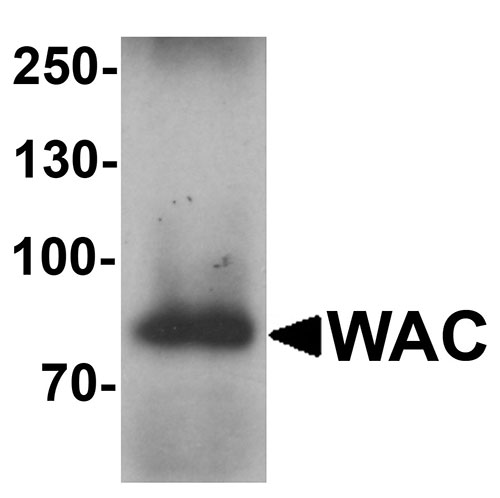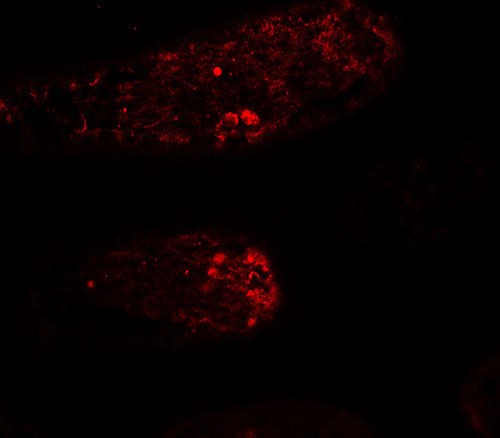WAC Antibody
- SPECIFICATION
- CITATIONS
- PROTOCOLS
- BACKGROUND

Application
| WB, IHC-P, IF, E |
|---|---|
| Primary Accession | Q9BTA9 |
| Other Accession | NP_057712, 18379328 |
| Reactivity | Human, Mouse, Rat |
| Host | Rabbit |
| Clonality | Polyclonal |
| Isotype | IgG |
| Calculated MW | Predicted: 71 kDa Observed: 75 kDa |
| Application Notes | WAC Antibody can be used for detection of WAC by Western blot at 1 µg/mL. |
| Gene ID | 51322 |
|---|---|
| Target/Specificity | WAC; At least two isoforms of WAC are known to exist; this antibody will detect the larger isoform. |
| Reconstitution & Storage | WAC antibody can be stored at 4℃ for three months and -20℃, stable for up to one year. |
| Precautions | WAC Antibody is for research use only and not for use in diagnostic or therapeutic procedures. |
| Name | WAC |
|---|---|
| Synonyms | KIAA1844 |
| Function | Acts as a linker between gene transcription and histone H2B monoubiquitination at 'Lys-120' (H2BK120ub1) (PubMed:21329877). Interacts with the RNA polymerase II transcriptional machinery via its WW domain and with RNF20-RNF40 via its coiled coil region, thereby linking and regulating H2BK120ub1 and gene transcription (PubMed:21329877). Regulates the cell-cycle checkpoint activation in response to DNA damage (PubMed:21329877). Positive regulator of amino acid starvation-induced autophagy (PubMed:22354037). Also acts as a negative regulator of basal autophagy (PubMed:26812014). Positively regulates MTOR activity by promoting, in an energy-dependent manner, the assembly of the TTT complex composed of TELO2, TTI1 and TTI2 and the RUVBL complex composed of RUVBL1 and RUVBL2 into the TTT-RUVBL complex. This leads to the dimerization of the mTORC1 complex and its subsequent activation (PubMed:26812014). May negatively regulate the ubiquitin proteasome pathway (PubMed:21329877). |
| Cellular Location | Nucleus speckle {ECO:0000250|UniProtKB:Q924H7}. Nucleus. Note=In distinct nuclear speckles. Colocalizes with pre-mRNA processing complexes {ECO:0000250|UniProtKB:Q924H7} |

Thousands of laboratories across the world have published research that depended on the performance of antibodies from Abcepta to advance their research. Check out links to articles that cite our products in major peer-reviewed journals, organized by research category.
info@abcepta.com, and receive a free "I Love Antibodies" mug.
Provided below are standard protocols that you may find useful for product applications.
Background
WAC Antibody: The WW domain containing adaptor with coiled-coil protein (WAC) contains a WW domain that mediates protein-protein interactions and colocalizes with RNA splicing factor SC35. Further studies have indicated that WAC is a functional partner of the RNF20/40 complex that ubiquitinates Histone H2B, and that WAC regulates H2B ubiquitination. WAC targets RNF20/40 to associate with RNA polymerase II complex for H2B ubiquitination at active transcription sites. WAC-dependent transcription is also important for cell-cycle checkpoint activation in response to genotoxic stress.
References
Xu GM and Arnaout MA. WAC, a novel WW domain-containing adapter with a coiled-coil region, is colocalized with splicing factor SC35. Genomics 2002; 79:87-94.
Zhang F and Yu X. WAC, a functional partner of RNF20/40, regulates histone H2B ubiquitination and gene transcription. Mol. Cell 2011; 41:384-97.
If you have used an Abcepta product and would like to share how it has performed, please click on the "Submit Review" button and provide the requested information. Our staff will examine and post your review and contact you if needed.
If you have any additional inquiries please email technical services at tech@abcepta.com.













 Foundational characteristics of cancer include proliferation, angiogenesis, migration, evasion of apoptosis, and cellular immortality. Find key markers for these cellular processes and antibodies to detect them.
Foundational characteristics of cancer include proliferation, angiogenesis, migration, evasion of apoptosis, and cellular immortality. Find key markers for these cellular processes and antibodies to detect them. The SUMOplot™ Analysis Program predicts and scores sumoylation sites in your protein. SUMOylation is a post-translational modification involved in various cellular processes, such as nuclear-cytosolic transport, transcriptional regulation, apoptosis, protein stability, response to stress, and progression through the cell cycle.
The SUMOplot™ Analysis Program predicts and scores sumoylation sites in your protein. SUMOylation is a post-translational modification involved in various cellular processes, such as nuclear-cytosolic transport, transcriptional regulation, apoptosis, protein stability, response to stress, and progression through the cell cycle. The Autophagy Receptor Motif Plotter predicts and scores autophagy receptor binding sites in your protein. Identifying proteins connected to this pathway is critical to understanding the role of autophagy in physiological as well as pathological processes such as development, differentiation, neurodegenerative diseases, stress, infection, and cancer.
The Autophagy Receptor Motif Plotter predicts and scores autophagy receptor binding sites in your protein. Identifying proteins connected to this pathway is critical to understanding the role of autophagy in physiological as well as pathological processes such as development, differentiation, neurodegenerative diseases, stress, infection, and cancer.




